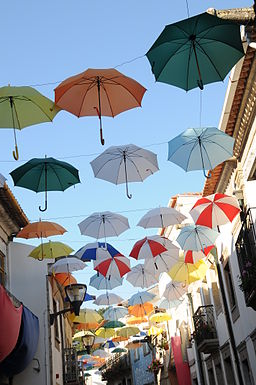Made in the Shade

Umbrellas overhang a street in Vila Nova de Cerveira, Portugal, as part of an arts festival in August 2013. The original display of umbrellas in this way was in the Portuguese city of Águeda in 2011. Photo by Joseolgon.
1) In order to be useful, the device should shade an area no less than 100 square feet, and still fold up compactly enough to fit in a small kit bag. It should weigh less than 20 pounds.
2) The device should remain stable on uneven ground and in the wind, though obviously within reason in both cases, and it should do so without the use of heavy weights.
3) One reasonably fit person should be able to erect the device or fold it up within a minute, and it should be easy for that person to move the device from one location to the next, also within a minute.
4) The shading material should be shade cloth with a density ranging from 60 to 80 percent, which allows cooling breezes through, is lighter than a more tightly woven fabric, and remains more stable in the wind.
5) The supports should be strong, light, and corrosion resistant. Use of spikes to anchor the device is inadvisable since shallowly penetrating spikes can be unreliable, and deeply penetrating ones negate portability.
6) Ideally it should cost less than $100, and definitely no more than $200, even though it should be able to take some rough treatment and last a decade or more.
Is that too much to ask? Certainly it may be too late to have the new Shade Giver ready this year, but surely by next year, when summer heat starts seeping in by April or May, some enterprising person will have created a prototype that could become the new Gardener’s Friend. Perhaps instead of a sail it will resemble one of the shells of the Sydney Opera House. Whatever the design of the device, it should bring sweet relief to those who must labor under the hot sun and still not hurt their backs or pocketbooks. In these warming times, asking for the protection provided by shade has become a necessary request.

The Saga Siglar, a replica of a Viking ship, sails near Australia’s Sydney Opera House in September 1985. Photo by Islandmen.


